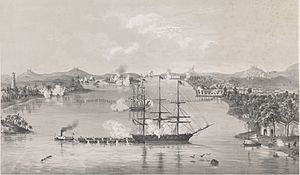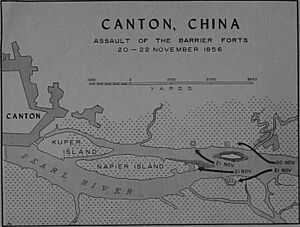Battle of the Barrier Forts facts for kids
Quick facts for kids Battle of the Barrier Forts |
|||||||
|---|---|---|---|---|---|---|---|
| Part of the Second Opium War | |||||||
 Attack on the Barrier Forts on November 21, showing Portsmouth, and Levant, with men and officers from the steam frigate San Jacinto |
|||||||
|
|||||||
| Belligerents | |||||||
| Commanders and leaders | |||||||
| Units involved | |||||||
|
|
Eight Banners Green Standard Army |
||||||
| Strength | |||||||
| 50 marines 237 sailors (on land) 1 steam frigate 2 sloops |
5,000 (garrison force) 3,000 (non-garrison force) |
||||||
| Casualties and losses | |||||||
| 10 killed 22 wounded 2 sloops damaged |
250–500 killed or wounded 176 guns lost 4 forts captured |
||||||
The Battle of the Barrier Forts (also called the Battle of the Pearl River Forts) happened in November 1856. It was a fight between American and Chinese forces. This battle took place on the Pearl River in Guangdong, China. It was part of a bigger conflict called the Second Opium War.
During this battle, the United States Navy launched an attack from both land and sea. They targeted four forts known as the Barrier Forts. These forts were located near the city of Canton, which is now called Guangzhou. The British, who wanted to capture Canton, saw this battle as very important.
Why the Battle Happened
Two American warships, the USS Portsmouth and the USS Levant, were sailing near the Chinese coast. They heard that the Second Opium War had started. Their job was to protect American citizens living in China. So, they sent about 150 marines and sailors into the city of Canton.
The American troops landed peacefully and took control of the old city. Later, another American warship, the USS San Jacinto, arrived in Canton's harbor. Its commander, Commodore James Armstrong, and Captain Henry H. Bell learned about the occupation. The San Jacinto then sent its own group of sailors to join the forces on land.
On November 15, 1856, after a short stay with no fighting, the American troops left the city. As they were leaving, Commander Andrew H. Foote of the Portsmouth was rowing back to his ship. When his small boat passed the Pearl River Forts, the Chinese soldiers in the forts fired at him a few times. However, the Americans continued their withdrawal.
The very next day, the American sailors decided to get even. They planned to attack the Chinese forts in Canton because of the shots fired at Commander Foote.
The Battle Begins
Now, the American naval group had one steam frigate (the San Jacinto) and two sloops-of-war (the Portsmouth and the Levant). This group, led by James Armstrong, sailed up the Pearl River. They began their attack on Canton's forts. On November 16, the USS Portsmouth moved close to the first fort and fired its guns.
The Portsmouth kept firing for two hours until the Chinese guns in the fort stopped. After this first fight, American and Chinese leaders tried to talk things out peacefully. But their talks failed. So, on November 20, Commodore Armstrong ordered his ships to fire again, this time on two more Chinese forts.
The ships kept firing until the Chinese guns became weaker. During this time, the Levant, led by William N. Smith, was hit 22 times by cannonballs. Its sails, ropes, and hull were damaged. While the ships were firing, a group of 287 American troops landed on shore. They were led by Commander Foote and faced no resistance at first. About 50 marines under Captain John D. Simms and a small group of sailors led the way. They quickly captured the first enemy fort. Then, they used the 53 guns from that fort to attack and capture the second fort.
When the Americans took the second fort, the Chinese launched several counterattacks. About 3,000 Qing Army soldiers from Canton tried to push them back. For a few more days, until November 24, the American forces fought hard. With help from their ships, they pushed back the Chinese army. They killed or wounded many Chinese soldiers. The Americans also captured two more forts and destroyed 176 enemy guns.
The Chinese forces had an estimated 250 to 500 soldiers killed or wounded. The American land forces lost seven men killed and 22 wounded. The USS Levant had one sailor killed and six wounded during its fight with the Pearl River Forts. The Portsmouth was hit 18 times and the Levant 22 times, but neither ship was badly damaged.
What Happened Next
After James Armstrong's attack on the Chinese forts, both sides tried diplomacy again. The American and Chinese governments signed an agreement. This agreement said that the United States would stay neutral, meaning they would not take sides in the Second Opium War. This ended America's part in the conflict for a while.
However, in 1859, Commodore Josiah Tattnall III joined the Battle of Taku Forts in a rented steamship called Towey Wan. That battle was not successful for the Americans. In 1857, the British and French forces used the Pearl River to attack Canton from the water. This led to the Battle of Canton. America continued to be involved in Asia in the 1860s. This included conflicts like the Battle of Shimonoseki Straits and a later bombardment. There was also an expedition to Korea in the 1870s.


